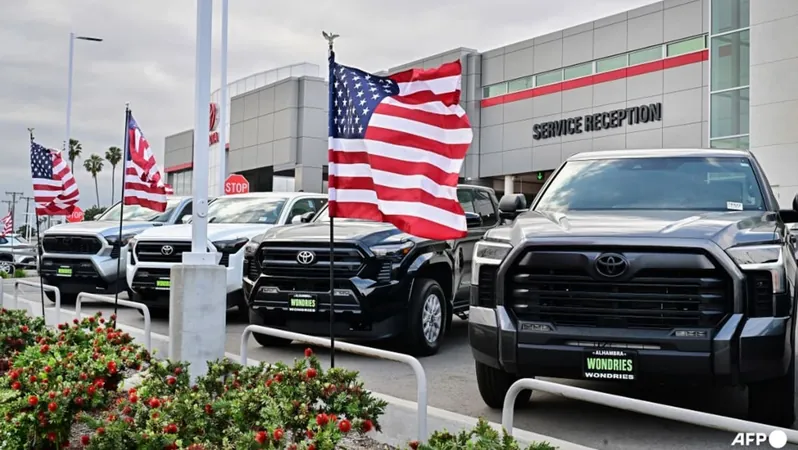
How Trump's High-Stakes Auto Tariffs Will Reshape the Automotive Landscape
2025-03-28
Author: Jia
In a bold move that has sent ripples through the global automotive industry, former President Donald Trump announced on March 26 that the United States will impose a sweeping 25% import tax on all vehicles and major automotive parts not produced in the U.S. This decision, effective April 3 for vehicles and May 3 for parts, has raised eyebrows on an international scale, particularly in nations like Japan and South Korea, which rely heavily on exports to America.
What Do the Tariffs Entail?
The new tariffs will apply to a wide range of automotive components, from engines and transmissions to vital electrical parts. Cars built under the US-Mexico-Canada Agreement (USMCA) may qualify for reduced tariffs if they meet specific criteria related to American content. For example, a vehicle assembled in Mexico with 45% U.S. parts would incur a 25% tariff on the remaining 55% of its value. However, the intricacies involved in verifying these content levels are complex, leaving many in the industry uncertain.
Who Faces the Brunt of This Financial Hit?
The primary victims of Trump's tariffs will be global automakers that export a significant proportion of their vehicles to the U.S. Major car manufacturers like Toyota, Honda, and Hyundai have already seen their stock prices tumble following the tariff announcement. With these three companies accounting for roughly a third of the U.S. market share, their financial stakes are significant. Additionally, brands such as Ferrari have announced price hikes of 10% on selected models, while parts suppliers like France's Valeo claim they will also have to increase prices.
What Does This Mean for the Global Automotive Sector?
The announcement disrupts decades of carefully structured global supply chains that have made manufacturing efficient and cost-effective. Industry experts, like Steven Okun, CEO of APAC Advisors, believe it will take years to restore equilibrium as manufacturers grapple with the complexity of supply routes that often span multiple countries. Even American automakers like General Motors and Ford, which heavily depend on imports, are bracing for the impact. Interestingly, Elon Musk from Tesla, despite manufacturing all vehicles domestically, noted that the tariffs would still raise production costs due to reliance on imported parts, showcasing the far-reaching effects of these tariffs.
Implications for U.S. Automakers
American manufacturers are now faced with the daunting task of increasing the domestic content of their vehicles—a challenge that could take years to navigate successfully. Some might consider building new factories in the U.S., but the concern looms that tariffs could vanish with a change in administration, jeopardizing future investments. Cox Automotive predicts a staggering disruption to "virtually all" North American vehicle output by mid-April, with estimates suggesting production could decline by approximately 20,000 cars daily—a jaw-dropping 30% cut.
Consumers Will Feel the Financial Strain
As expected, these tariffs will translate into higher costs for consumers. Experts predict that car prices could surge by an average of $5,000, effectively pricing many families out of the new car market and compelling them to cling to older vehicles. Moreover, in a bid to provide relief, Trump hinted at a potential policy that could allow consumers to deduct interest paid on auto loans for vehicles manufactured in the U.S., indicating a mix of support and incentive amidst rising costs.
The Rationale Behind the Tariffs
Trump's decision is ostensibly based on a 2019 national security investigation, which concluded that the growing market for imported vehicles posed a threat to the U.S. industrial base and military readiness. The former president had initially opted for negotiations over tariffs but ultimately deemed those efforts a failure as he cited worsening security concerns. The administration anticipates generating roughly $100 billion annually from these tariffs to help offset the financial impacts of Trump’s tax cuts promised during his campaign.
Conclusion
In essence, Trump's tariffs on imported vehicles could redefine the American automotive marketplace. While he aims to bolster domestic manufacturing, the unintended consequences could ripple through both the automotive industry and consumer wallets, ushering in a new era fraught with uncertainty and potential economic repercussions. As this situation unfolds, stakeholders across the globe will be watching closely to see how these measures impact both the industry and consumers alike.



 Brasil (PT)
Brasil (PT)
 Canada (EN)
Canada (EN)
 Chile (ES)
Chile (ES)
 Česko (CS)
Česko (CS)
 대한민국 (KO)
대한민국 (KO)
 España (ES)
España (ES)
 France (FR)
France (FR)
 Hong Kong (EN)
Hong Kong (EN)
 Italia (IT)
Italia (IT)
 日本 (JA)
日本 (JA)
 Magyarország (HU)
Magyarország (HU)
 Norge (NO)
Norge (NO)
 Polska (PL)
Polska (PL)
 Schweiz (DE)
Schweiz (DE)
 Singapore (EN)
Singapore (EN)
 Sverige (SV)
Sverige (SV)
 Suomi (FI)
Suomi (FI)
 Türkiye (TR)
Türkiye (TR)
 الإمارات العربية المتحدة (AR)
الإمارات العربية المتحدة (AR)